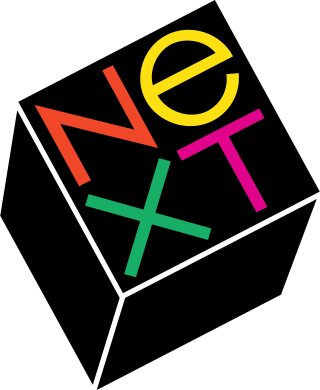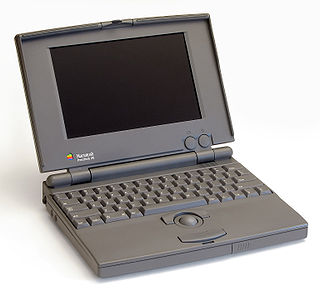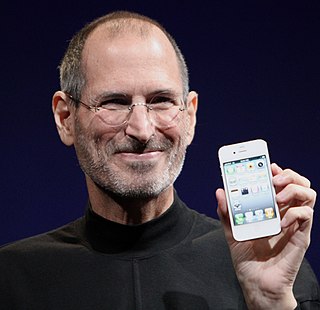Related Research Articles

Apple Inc. is an American multinational technology company headquartered in Cupertino, California. Apple is the world's largest technology company by revenue, with US$394.3 billion in 2022 revenue. As of March 2023, Apple is the world's biggest company by market capitalization. As of June 2022, Apple is the fourth-largest personal computer vendor by unit sales and the second-largest mobile phone manufacturer in the world. It is considered one of the Big Five American information technology companies, alongside Alphabet, Amazon, Meta Platforms, and Microsoft.

NeXT, Inc. was an American technology company headquartered in Redwood City, California that specialized in computer workstations for higher education and business use. The company was founded by Apple Computer co-founder and CEO Steve Jobs after he was forcibly removed from Apple in 1985. NeXT introduced its first product, the NeXT Computer, in 1988, followed by the smaller NeXTcube and NeXTstation in 1990. These computers had relatively limited sales, with only about 50,000 units shipped in total. Nevertheless, their object-oriented programming and graphical user interfaces were trendsetters of computer innovation, and highly influential.

The Power Macintosh, later Power Mac, is a family of personal computers designed, manufactured, and sold by Apple Computer as the core of the Macintosh brand from March 1994 until August 2006.

Taligent Inc. was an American software company. Based on the Pink object-oriented operating system conceived by Apple in 1988, Taligent Inc. was incorporated as an Apple/IBM partnership in 1992, and was dissolved into IBM in 1998.

The AIM alliance, also known as the PowerPC alliance, was formed on October 2, 1991, between Apple, IBM, and Motorola. Its goal was to create an industry-wide open-standard computing platform based on the POWER instruction set architecture. It was intended to solve legacy problems, future-proof the industry, and compete with Microsoft's monopoly and the Wintel duopoly. The alliance yielded the launch of Taligent, Kaleida Labs, the PowerPC CPU family, the Common Hardware Reference Platform (CHRP) hardware platform standard, and Apple's Power Macintosh computer line.

The Macintosh Classic is a personal computer designed, manufactured and sold by Apple Computer from October 1990 to September 1992. It was the first Macintosh to sell for less than US$1,000.

John Sculley III is an American businessman, entrepreneur and investor in high-tech startups. Sculley was vice-president (1970–1977) and president of PepsiCo (1977–1983), until he became chief executive officer (CEO) of Apple Inc. on April 8, 1983, a position he held until leaving in 1993. In May 1987, Sculley was named Silicon Valley's top-paid executive, with an annual salary of US$10.2 million.
Macworld/iWorld was an information technology trade show with conference tracks dedicated to Apple's Mac platform. It was held annually in the United States during January. Originally Macworld Expo and then Macworld Conference & Exposition, the gathering dates back to 1985. The conference was organized by International Data Group (IDG), co-publisher of Macworld magazine.
Jean-Louis Gassée is a business executive. He is best known as a former executive at Apple Computer, where he worked from 1981 to 1990. He also founded Be Inc., creators of the BeOS computer operating system. After leaving Be, he became Chairman of PalmSource, Inc. in November 2004.
Michael Spindler was a German businessman who was president and CEO of Apple from 1993 to 1996. Spindler was born in Berlin.

The Apple Macintosh—later rebranded as the Macintosh 128K—is the original Apple Macintosh personal computer. It played a pivotal role in establishing desktop publishing as a general office function. The motherboard, a 9 in (23 cm) CRT monitor, and a floppy drive were housed in a beige case with integrated carrying handle; it came with a keyboard and single-button mouse. It sold for US$2,495. The Macintosh was introduced by a television commercial entitled "1984" shown during Super Bowl XVIII on January 22, 1984 and directed by Ridley Scott. Sales of the Macintosh were strong at its initial release on January 24, 1984, and reached 70,000 units on May 3, 1984. Upon the release of its successor, the Macintosh 512K, it was rebranded as the Macintosh 128K. The computer's model number was M0001.
Star Trek is the code name that was given to a secret prototype project, running a port of Macintosh System 7 and its applications on Intel-compatible x86 personal computers. The project, starting in February 1992, was conceived in collaboration between Apple Computer, who provided the majority of engineers, and Novell, who at the time was one of the leaders of cross-platform file-servers. The plan was that Novell would market the resulting OS as a challenge to Microsoft Windows, but the project was discontinued in 1993 and never released, although components were reused in other projects. The project was named after the Star Trek science fiction franchise with the slogan "To boldly go where no Mac has gone before".
Bedrock was a joint effort by Apple Computer and Symantec to produce a cross platform programming framework for writing applications on the Apple Macintosh and Microsoft Windows platforms. The project was a failure for a variety of reasons, and after delivering a developer preview version the project was abandoned in late 1993.
Armas Clifford "Mike" Markkula Jr. is an American electrical engineer, businessman and investor. He was the original angel investor, first chairman, and second CEO for Apple Computer, Inc., providing critical early funding and managerial support. At the company's incorporation, Markkula owned 26% of Apple, equivalent to each of the shares owned by cofounders Steve Jobs and Steve Wozniak.
Steve Capps is a pioneering American computer programmer and software engineer, who was one of the original designers of the Apple Macintosh computer and co-designers of the Finder in the 1980s. He also led development of the Apple Newton PDA and designed music software such as SoundEdit, before developing user interface (UI) designs for Microsoft's Internet Explorer and online/mobile payment systems.

Apple Inc., originally named Apple Computer, Inc., is a multinational corporation that creates and markets consumer electronics and attendant computer software, and is a digital distributor of media content. Apple's core product lines are the iPhone smartphone, iPad tablet computer, and the Macintosh personal computer. The company offers its products online and has a chain of retail stores known as Apple Stores. Founders Steve Jobs, Steve Wozniak, and Ronald Wayne created Apple Computer Co. on April 1, 1976, to market Wozniak's Apple I desktop computer, and Jobs and Wozniak incorporated the company on January 3, 1977, in Cupertino, California.

The PowerBook 100 is a portable subnotebook personal computer designed and manufactured by Sony for Apple Computer and introduced on October 21, 1991, at the COMDEX computer expo in Las Vegas, Nevada. Priced at US$2,500 with external floppy drive, the PowerBook 100 was the low-end model of the first three simultaneously released PowerBooks. Its CPU and overall speed closely resembled those of its predecessor, the Macintosh Portable. It had a Motorola 68000 processor at 16 MHz, 2-8 megabytes (MB) of RAM, a 9-inch (23 cm) monochrome backlit liquid crystal display (LCD) with 640 × 400 pixel resolution, and the System 7.0.1 operating system. It did not have a built-in floppy disk drive and was noted for its unique compact design that placed a trackball pointing device in front of the keyboard for ease of use.

Steven Paul Jobs was an American business magnate, inventor, and investor. He was the co-founder, chairman, and CEO of Apple; the chairman and majority shareholder of Pixar; a member of The Walt Disney Company's board of directors following its acquisition of Pixar; and the founder, chairman, and CEO of NeXT. He was a pioneer of the personal computer revolution of the 1970s and 1980s, along with his early business partner and fellow Apple co-founder Steve Wozniak.

The Mac, short for Macintosh, is a family of personal computers designed and marketed by Apple Inc. The product lineup includes the MacBook Air and MacBook Pro laptops, as well as the iMac, Mac Mini, Mac Studio and Mac Pro desktops. Macs are sold with the macOS operating system.

The Newton is a series of personal digital assistants (PDAs) developed and marketed by Apple Computer, Inc. An early device in the PDA category, it was the first to feature handwriting recognition. Apple started developing the platform in 1987 and shipped the first devices in August 1993. Production officially ended on February 27, 1998. Newton devices ran on a proprietary operating system, Newton OS; examples include Apple's MessagePad series and the eMate 300, and other companies also released devices running on Newton OS. Most Newton devices were based on the ARM 610 RISC processor and all featured handwriting-based input.
References
- ↑ Clapes, Anthony Lawrence (November 1989). Software, copyright, and competition: the "look and feel" of the law. Quorum Books. p. 32. ISBN 978-0-89930-507-3.
- ↑ Carlton, Jim (1997). Apple: The Inside Story of Intrigue, Egomania, and Business Blunders. Times Business/Random House. p. 216. ISBN 978-0-88730-965-6.
- ↑ "The story behind Steve Jobs' 1985 resignation from Apple | Edible Apple".
- ↑ Information Access Company (September 1981). Datamation. Technical Publishing. p. 167.
- ↑ Sculley, John; Byrne, John A. (1 January 1989). Odyssey: Pepsi to Apple-- a journey of adventure, ideas and the future. Stoddart Publishing. p. 208. ISBN 978-0-7737-5205-4.
- ↑ California Lawyer. State Bar of California. 2004. p. 27.
- ↑ Mexico update. American Chamber of Commerce of Mexico. 1982. p. 157.
- ↑ InfoWorld Media Group (9 September 1985). InfoWorld. InfoWorld Media Group. pp. 3–. ISSN 0199-6649.
- ↑ Computer Law Reporter. Computer Law Reporter Incorporated. 1994. p. 567.
- ↑ Rose, Frank (1990). West of Eden: The End of Innocence at Apple Computer. Frank Rose. pp. 300 and various pages. ISBN 978-0-14-009372-8.
- ↑ Manes, Stephen; Andrews, Paul (21 January 1994). Gates: How Microsoft's Mogul Reinvented an Industry--and Made Himself the Richest Man in America. Touchstone Books. p. 357. ISBN 978-0-671-88074-3.
- ↑ Linzmayer, Owen W. (1 January 2004). Apple Confidential 2.0: The Definitive History of the World's Most Colorful Company. No Starch Press. pp. 149–. ISBN 978-1-59327-010-0.
- ↑ "Michael Spindler: The Peter Principle at Apple". Low End Mac. August 18, 2013.
- ↑ Markoff, John. "A Search for Direction at Apple". The New York Times , October 1, 1993.
- ↑ MacUser. Dennis Publishing. January 1994. p. 93.